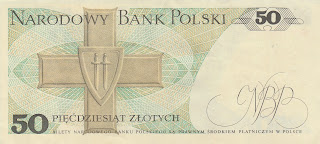The three Polish notes above are all from the inter war period (1919-1939) but all have stamps which lead us to believe that they were still in use in 1939. Germany tried to occupy the whole of Poland in 1939 but, by breaking an accord with Soviet Russia , meant that Russia held half of Poland and Germany the other half until !941 when Germany went on the offensive and took the rest of Poland and went on to attack on the Eastern Front, the rest of Russia.
The first note above is the 50 Zlotych note from 1929. and you will see it has an overprint of the Deutsche LuftPost (german airmail) and the eagle and swastika of Nazi Germany. It also has the number 1024 which I am still researching to see what it signifies.
Next is the 100 Zlotych note from 1932, again with the Deutsche Luftpost stamp. it has Prince Jozef Poniatowski on the front and an oak tree on the reverse signifying the history of Poland.
The final note in this section above, is the 20 Zlotych note from 1936. now the overprint stamps are different and carry the SS sign and different wording - which i cant make out - the note itself has
Countess Emilia Plater on the front and
Wawel Castle in
Krakow
the two notes above are the 1000 Zlotych and 500 Zlotch notes Respectively and you can find a description
HERE . The only thing of note is the square stamp on the 500 Zlotych note which has a
Masonic symbol on it and the ink has seeped through the paper to give it a see-through like lady's nylon stockings !!!

















































